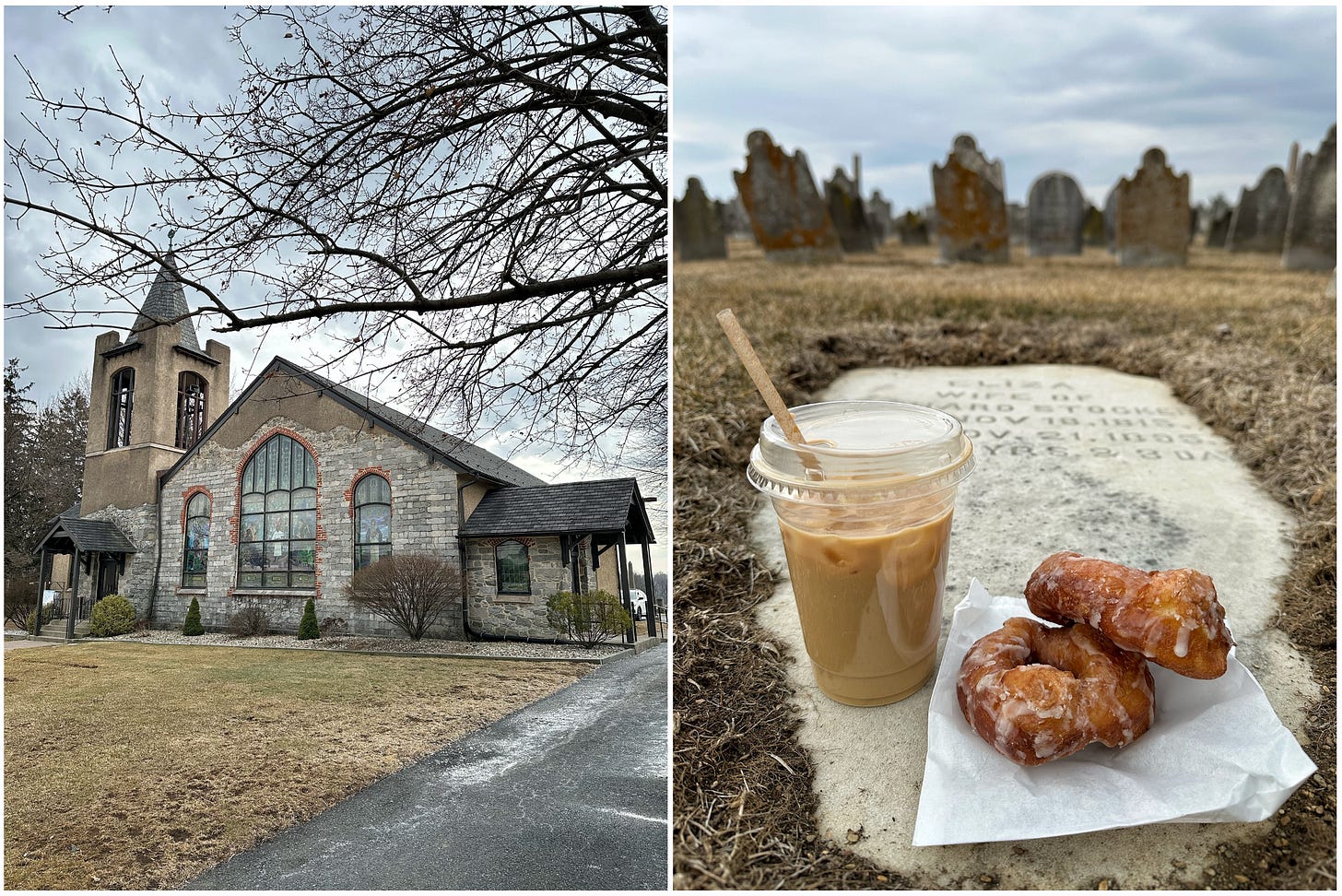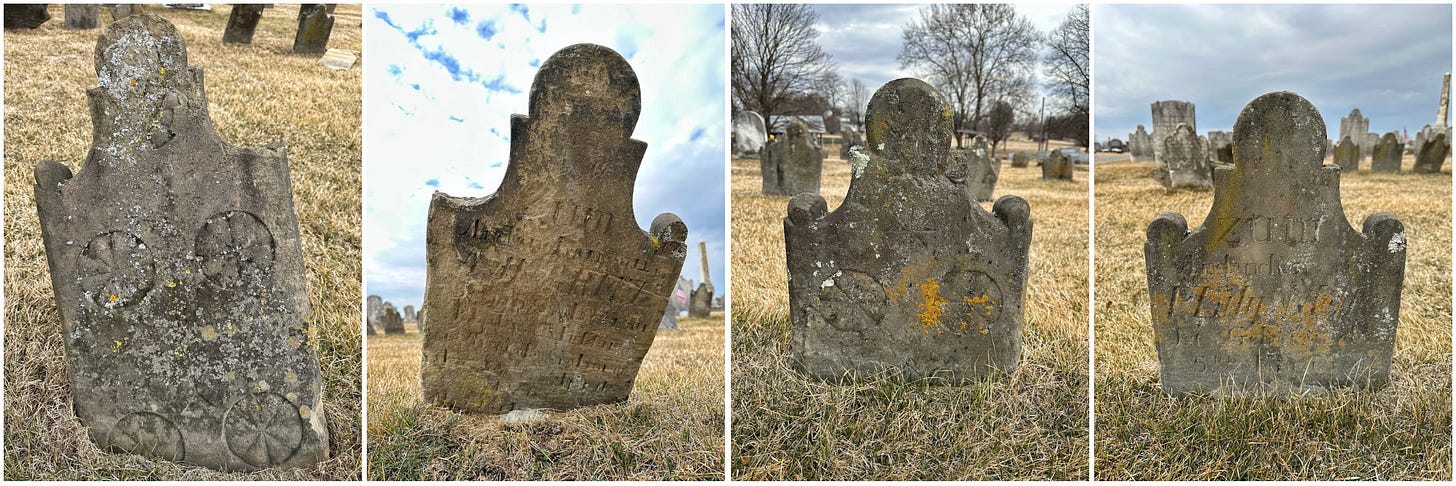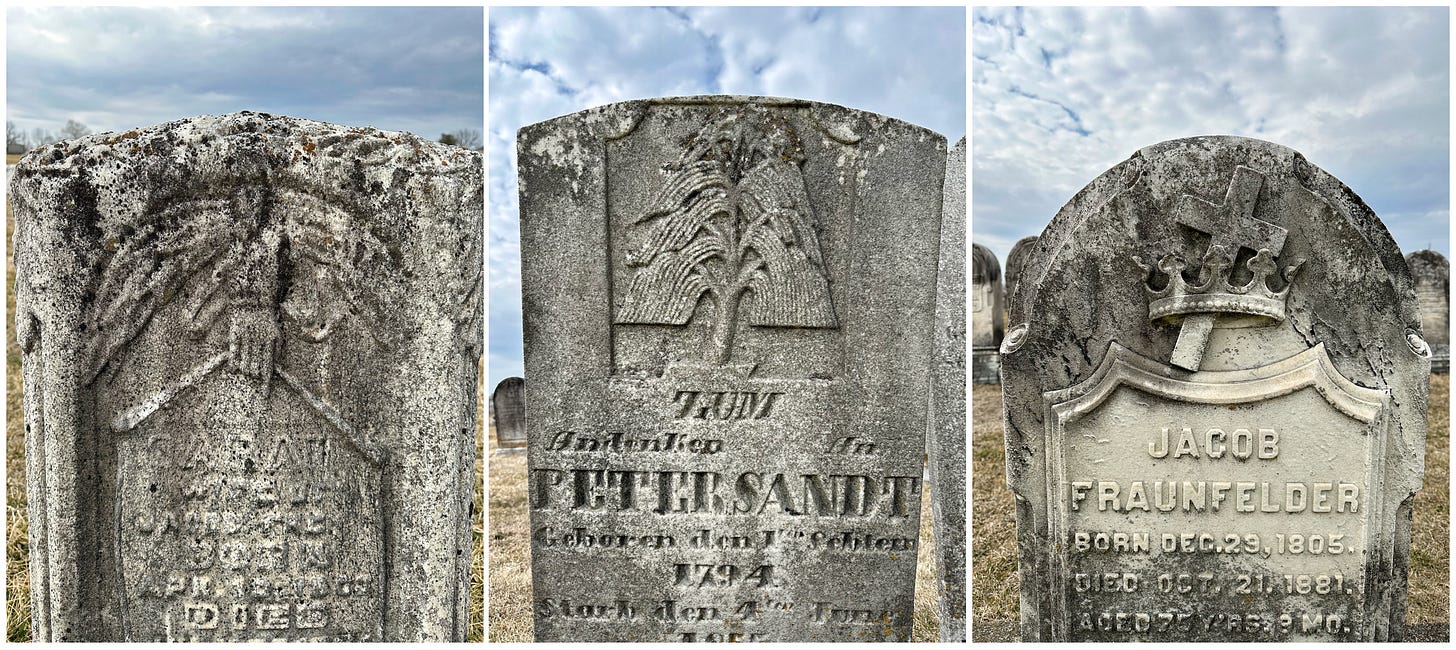Sunday Pastries With the Dead 46
The 1747-era Forks Cemetery in Forks, PA.
Let’s just get this out of the way for the Twilight fans: yes, there’s a Forks in Pennsylvania, too! Instead of sparkly vampires, it’s home to an amazing Mediterranean deli and a fantastic 1747-era cemetery that features work by one of the county’s prolific (and recently-discovered!) late-1700s carvers.
I had a bit of an oh nooooo, what have I done moment while pulling into the church parking lot adjacent to this cemetery. There are so. many. headstones. 6,114 burials, to be exact. But I stayed laser-focused on the slate and sandstone slabs in the oldest section closest to the church, and even had time to browse the adjacent marble markers, many of which have been largely decimated by the elements. In truth, I’ve become such a Colonial-era carving snob that if I drive by a cemetery and see nothing but marble, I think, “Eh, 1800s…too old.”
As usual, I’m dating this cemetery to its earliest interred on record (Anna Christine Stecher, who died in 1747) as opposed to the official date of establishment, which—according to church records—was 1808. As you’ll see by the language on many of the stones, the congregation was founded by Lutheran and Reformed Germans who immigrated to this area starting in the 1730s, to escape persecution in their home country. The house of worship began as a barn, and a church was constructed in 1812. In 1912, the church was rebuilt to the structure standing today.
Let’s start with our aforementioned carver friend, since he worked on at least one of the oldest stones here. He was initially known as the “Northampton County Carver” (named for this Pennsylvania county), but was identified in 2019 as Jacob Motz or Moots. His creations date from around 1760 to 1780, and his signature was to carve not just the front but also the back of headstones, which I find completely delightful. I actually encountered far better preserved examples of his work in Sunday Pastries 36 without realizing it at the time. Despite the weathering on these slabs, his designs are still identifiable. Most impressively, with the above geometric and floral motif (complete with flowers—depicting the tree of life—blooming from an urn), for Anna Eva Christina Kauffmann, who died in 1772.
This was the only floral motif I could find, but there were many others with interesting geometric patterns on the opposite sides, like these for Maria Magdalena Scherer Frey and Christina Plaiz Bauman, who both died in 1815. This death dates being after Motz passed, I’m guessing these were done by one of his apprentices or by another carver influenced by his work.
I also found evidence of someone, clearly following in Motz’s footsteps, who created recessed carved geometric flowers on the backs of several headstones. Maria Anna Shug died in 1830, at just eight months old. The technique and lettering on this is quite intricate and advanced—this could be our carver from the 1815 headstones, much improved in his craft, or someone new altogether.
Two more examples of headstones with those geometric flowers on the back—I was unable to decipher the left-most name and death date, but the stone on the right belongs to Philip Messinger, who died in 1828—these were all likely made by the same carver in the 1820s. Worth noting, since these are, in German, that “zum” means “to the” or “for the” and generally signifies “the remains of” or “here lies” as we know it—especially when paired with “andenken,” aka: “souvenirs.”
Despite extreme weathering, several portraits, soul effigies, and traditional symbols are still visible on headstone tympanums here. This is my favorite of the bunch—a portrait stone for 11-year-old Samuel VanEtten softened by time, dating to 1761. It also happens to be the oldest remaining stone in the cemetery. The quintessentially memento mori-style epitaph reads, “Ye living remember Eternity for your all born to die.” (Cue Lana Del Rey…)
A few others I loved are this portrait for Magdalena Sandt from 1801 (you can just make out her luxurious hair), this soul effigy (see the lines in the wings on each side of the face?) with tulips beneath (symbolizing eternal life and rebirth) from 1797, and this portrait of four-year-old Abraham VanEtten from 1763. The first two are clearly by the same carver, while Abraham’s is by the same maker as his brother Samuel’s above (what heartache for that family!)
As for symbols, I enjoy this geometric basket or urn design on Johan George’s 1840 stone, and these sunbursts on two-year-old Lita Babp’s 1803 stone and 18-day-old Maria Correll’s 1804 stone (the latter two are definitely from the same carver).
Among the memorials, I also spotted some Pennsylvania Clouded Limestone, very specific to this area, which I talked about in Sunday Pastries 40. The stone on the right, for Lidianna Correll, dates to 1826.
A few marble symbols of note, from my quick stroll through the many environmentally-melted monuments. Margaret Kachline’s 1870 stone is in shockingly great condition, especially considering that it has fallen flat on the ground, making it far more prone to water damage—this is an excellent example of how marble quality also aids in the stone’s longevity. Margaret’s stone features roses (grace, beauty, purity) and a sheaf of wheat (a long life well lived). Sabina Frace’s 1876 stone features a symbol for a marital handshake/God greeting her in heaven, Franklin Laros’ 1874 stone has ivy (immortality and everlasting love), Sarah Frey’s 1874 stone shows a hand pointing down (aka: she was taken quickly in death—I like the way the symbol is also incorporated to hold up the scroll design bearing her headstone information), Peter Sandt’s 1855 stone shows a nice geometric take on the traditional weeping willow tree (grief and mourning) and Jacob Fraunfelder’s 1881 stone is capped with a cross within a crown (eternal life in the kingdom of heaven).
It’s also worth mentioning that this cemetery has not one but two gazebos, which is a feature sorely lacking from the general graveyard experience. More octagonal pavilions within which to eat pastries and gaze upon the resting places of the dead, please and thank you!
That’s all for this latest cemetery visit—thanks for joining me! If you love these posts and want to help fund my research and reporting, you can upgrade to an optional paid subscription below. Until a future Sunday, fellow taphophiles!

















As always Katie, fascinating!! Thank you!